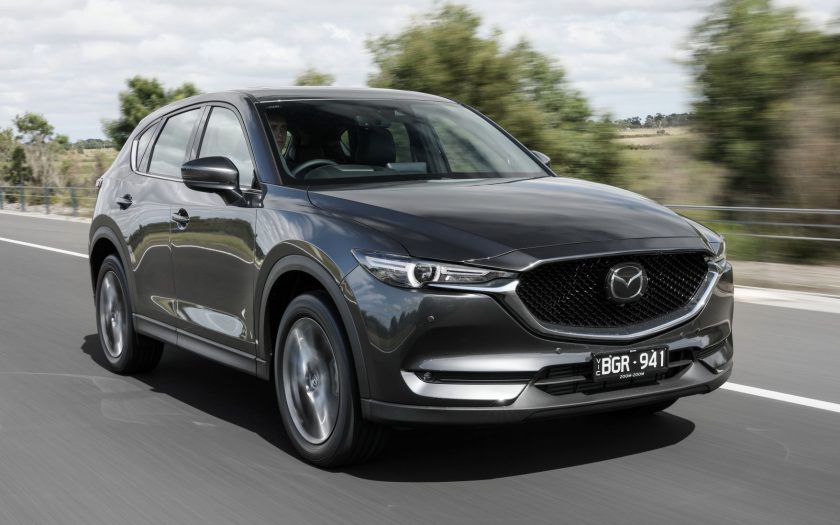Paul Murrell tests the 2020 Mazda CX-5 mid-size SUV with pricing, specs, ride and handling, safety, verdict and everything the over-50 driver needs to know.
Summary: With only a modest increase in price, the updated Mazda CX-5 offers sharper value for money in an increasingly tough category.
2020 Mazda CX-5 Akera mid-size SUV
Pricing: $51,240 (Akera, driveaway) Maxx from $32,990 (driveaway). Premium paint (Soul Red Crystal, Polymetal Grey metallic, Machine Grey) $495
Warranty: Five-years, unlimited km
Safety: 5-star ANCAP (tested 2017)
Engine: 2.5-litre four-cylinder turbo petrol
Power: 170kW at 5000rpm (a handy increase over the non-turbo models)
Torque: 420Nm at 2000rpm (almost what you’d expect from a diesel)
Transmission: six-speed automatic (Mazda has resisted the temptation to add extra ratios)
Drive: all wheel drive
Body: 4550mm (long); 1840mm (wide); 1680mm (high)
Ground clearance: 193mm
Cargo area: 442-1342 litres
Weight: 1720kg
Towing capacity: 2000kg, braked, 750kg unbraked (non-turbo models can only tow 1800kg unbraked)
Towball download maximum: 150kg
Tyres: 225/55 R19
Spare wheel: emergency (185/80 R17) (still unacceptable for long distance touring)
Turning circle: 11.0m (kerb to kerb)
Fuel tank: 58 litres
Thirst: 8.2L/100km (combined, 91 RON unleaded) (thirstier than the competition)
seniordriver consumption: 9.9L/100km over 214km
[review]
SUVs LIKE THE MAZDA CX-5 have really taken off with Australian buyers. Families use them for the school run. Over-50s hitch up a caravan and take off around Australia (well, they did before the border lock-down, and signs are good that they’ll be able to head off again soon).
The thing is, though, other SUVs have been catching up and are offering apparently better value for money, more features and more recent styling changes.
Case in point: the Toyota RAV4. Booming sales have put the RAV4 on track to overtake the Mazda CX-5 and become Australia’s best-selling SUV. The Toyota is priced from $32,695 (the 2.0-litre GX 2WD, plus on road costs) and climbs to $48,915 for the 2.5-litre AWD Edge. Toyota doesn’t offer a diesel variant, but there are hybrid models (2WD 2.5-litre GX for $37,070, 2.5-litre GXL at $39,915, 2.5-litre Cruiser at $43,415, all plus on road costs). All-wheel drive hybrid models range from $40,070 up to $46,415.
So the real question for over-50s buyers is does the Mazda still stack up.
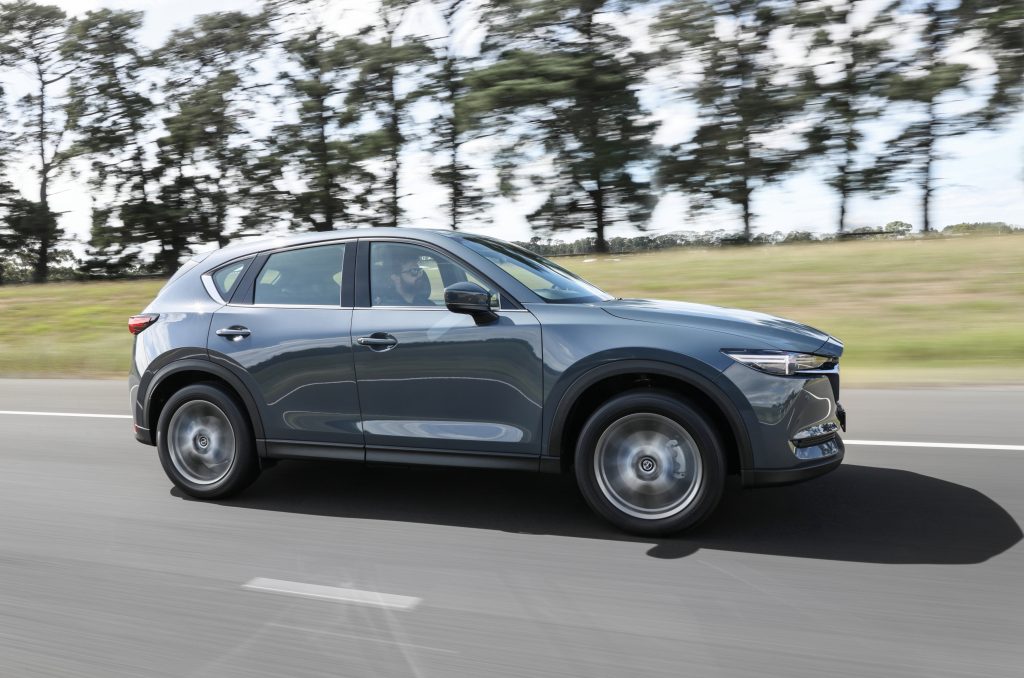
Minor upgrades, minor price increases
Mazda has hardly pushed the boat out with its revisions to the CX-5 for 2020. In some ways, they probably don’t have to, since the product is already well equipped and well-finished, especially at this top end of the range. Price increases have been kept to almost nominal amounts ($100 to $200 for most models).
The engine in the Akera turbo is unchanged, although you can opt for the non-turbo version or, unlike the Toyota, a diesel variant. For some buyers, especially those planning long trips, the diesel engine may swing the decision in Mazda’s favour.
The most important new feature in the Mazda for 2020 is off-road traction assist for the all-wheel-drive system. Put simply, this locks power to all four wheels (under normal circumstances, power is sent only to the rear wheels on demand). If a wheel loses traction, it can brake the spinning wheel and divert power to those wheels with traction.
The advantages off-road are considerable. However, if you aren’t serious about off-roading, the benefits are diluted.
Other upgrades for the new model are an improvement to the autonomous emergency braking to detect pedestrians at night, paddle shifters mounted on the steering wheel, a larger infotainment display (up to 8-inches from seven) and additional insulation to reduce NVH (noise, vibration, harshness) when cruising.
External changes will keep anoraks happy, but the rest of us won’t notice, or care. Badges on the tailgate get a new typeface.
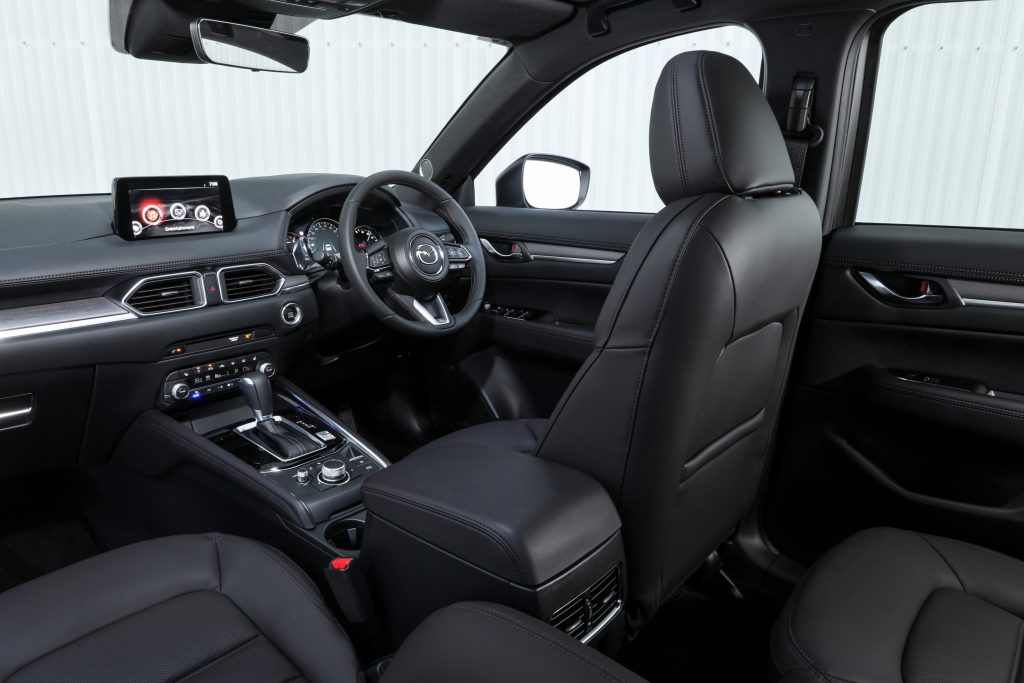
Extensive equipment list
At almost $20,000 more than the entry level CX-5, the range-topping Akera 2.5T is comprehensively equipped. Equipment shared with lower grade models includes dual zone climate control, power tailgate, auto headlights, auto wipers, proximity key with push button start, 19-inch alloy wheels, adaptive cruise control with stop-and-go, speed limiter, power adjustable front seats, 10-speaker Bose audio system, Apple CarPlay and Android Auto, digital radio and sat nav. To this, the Akera adds all-wheel drive, auto transmission, turbo boosted engine, adaptive LED headlights (including the ability to partially dim for oncoming traffic and greater penetration with highway mode), 7-inch digital instrument display, Nappa leather trim, 360-degree camera, ventilated and heated front seats, heated rear seats and of lesser value, a frameless interior mirror and heated steering wheel.
No shortage of grunt
The Akera’s turbo motor is shared with the larger CX-9, so in the smaller CX-5 performance is not an issue. Rated at 170kW and 420Nm, these figures are a useful increase over the non-turbo’s 140kW and 252Nm, well worth keeping in mind if you are considering towing.
However, we still take issue with Mazda’s fuel consumption which, at a quoted 8.2L/100km is considerable. Making things worse, over our time with the Akera, we clocked fuel consumption across a range of conditions (but no off-road) at 9.9L/100km, a figure we suspect will be more in line with that achieved by most owners. With a comparatively small fuel tank (58 litres), the Akera’s range may not suit all buyers.
On the plus side, it is happy to run on 91RON unleaded fuel.
Mazda has resisted the temptation to increase the number of gear ratios. The ‘box is a six-speed auto, and proved perfectly acceptable. It was quick to change, didn’t hesitate or hunt and maintained speed uphill and down. Of course, with that substantial torque of 420Nm, the auto transmission isn’t being put under any pressure.
The engine has a throaty exhaust note but at cruising speeds this is muted (100km/h equates to just under 2000rpm).
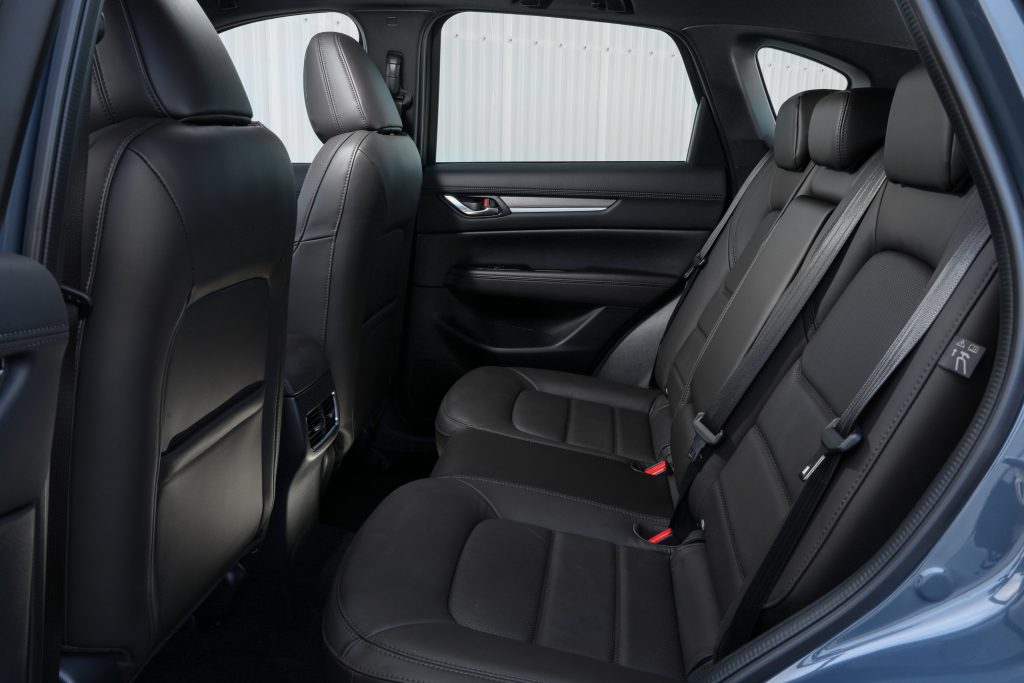
Pleasant touring
Over the years, Mazda has come in for some criticism about the amount of road noise. The new CX-5 has benefitted from additional attention to NVH. Mazda claims the new CX-5 is as quiet at 100km/h as the old one was at 80km/h.
Wind noise is acceptably low and very little road noise is transmitted to the cabin. Occasionally (particularly on coarse chip country road surfaces) a little tyre rumble is evident, but it is no worse than most other SUVs.
Steering feel and feedback find a happy medium. It is light enough at low speeds to make parking no chore and as speeds rise, there is sufficient feel to convey what is going on under the wheels, not something you can always say about all SUVs. Mazda’s G-Vectoring Control Plus reduces power slightly as you turn into a corner, improving grip and feel at the front. It restores power as you turn out. Most drivers won’t notice but it does make the car feel more capable.
As usual, the quality of the interior is a Mazda standout. Surfaces look and feel expensive, as you’d expect in a $50,000-plus car (there are even touches of real wood). The Nappa leather is beautifully finished; the dashboard is stylishly designed and superbly fitted; seats are supportive and make it easy to find a comfortable driving position; all the controls operate with a solid, high quality feel.
The rear seat makes a claim to being suitable for three, but is really more comfortable for two. Knee and head room are not particularly generous, however, the rear seat backrest can be slightly reclined to give rear seat passengers more comfort, especially on long distance journeys. Rear seat passengers will also appreciate the heated seats and air vents located at the rear of the console (although there is no separate temperature control).
Luggage space is 442 litres with the rear seats up (and not reclined) rising to 1342 litres when they are folded. The rear cargo-blind overcomes a regular problem in other vehicles by being attached to the tailgate, so it doesn’t get in the way. Clever thinking, Mazda!
Not so clever is Mazda’s perseverance with a space saver spare, which is less than ideal if you’re travelling long distances or going off road.
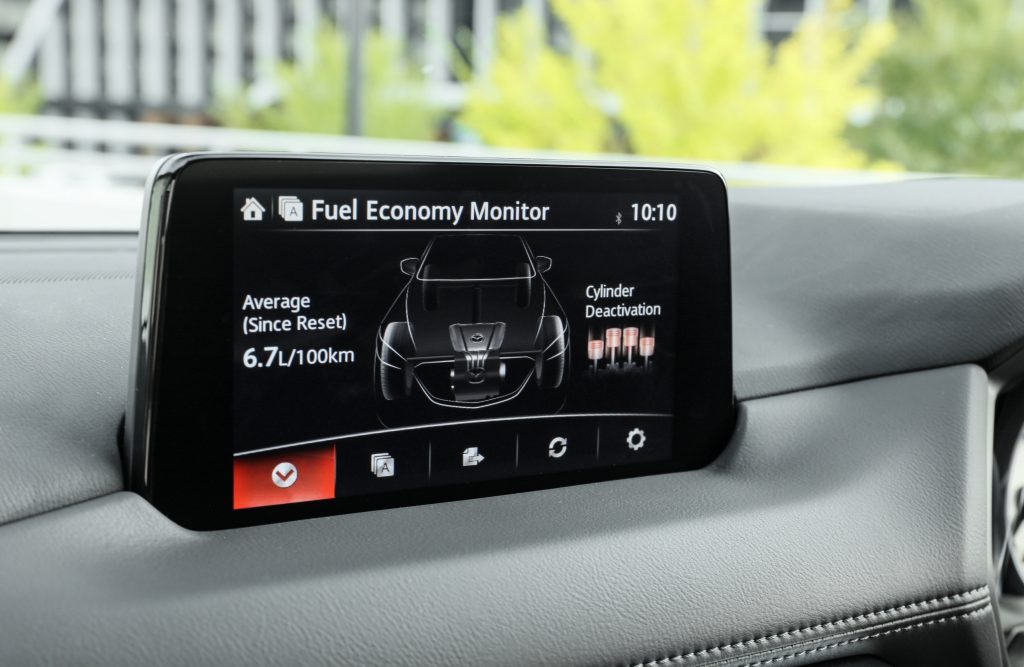
Safety without compromise
The CX-5 was rated five stars for safety in 2017.
It gets autonomous emergency braking at speeds up to 160km/h (upgraded to include pedestrian identification even in the dark), blind spot monitoring, rear cross traffic alert and six airbags (two for driver and passenger for frontal impacts, two more at chest level for side impacts and side curtain airbags to protect front and rear passengers).
Active safety features include lane keep assist (with gentle correction to bring you back into your lane), driver attention alert (checking your control inputs and warning you to take a break if they become erratic) and traffic sign recognition (which works surprisingly well) while the Akera adds auto headlights and wipers.
Servicing and ownership
Drivers planning to travel high mileages may need to take into account Mazda’s recommended service intervals of 10,000km (or every 12 months). Basic service costs are $347 for the first, third and fifth service, $378 for the second and fourth (brake fluid, air filter and cabin filter are additional costs).
The Mazda warranty is for five years and unlimited kilometres.
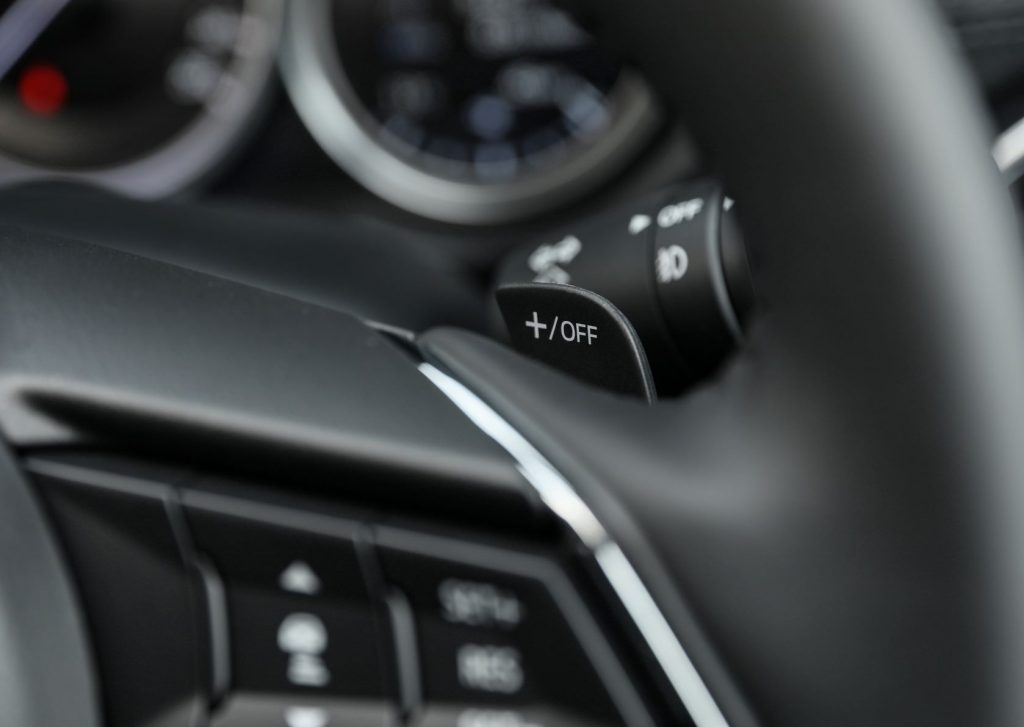
So, CX-5 or RAV4?
We started out by asking if the Mazda CX-5 has enough to offer to take on the fast-selling Toyota RAV4.
The top-spec models are the Akera as reviewed here, and the Toyota RAV4 Edge.
The Toyota is on a par when it comes to equipment, but Mazda trumps it for the luxury feel and quality of finish. The Toyota gets a claimed fuel consumption of 7.3L/100km, considerably more economical than the CX-5. The RAV4 was tested by ANCAP in 2019 (two years after the CX-5) and scored five stars.
The option of diesel will sway many buyers towards the Mazda, but the Toyota petrol engine (not turbocharged) is well down on power (152kW) and torque (243Nm) compared to the Mazda. The RAV4 Edge gets an eight-speed auto.
Towing capacity for the RAV4 is 1500kg (braked) compared to the Akera turbo’s 2000kg.
Summary
The Mazda CX-5 continues to be a well-presented, well-equipped mid-size SUV. The improvements for the 2020 model, although comparatively minor, improve what was already a very competent car, as its category-leading sales indicate.
While the price at more than $50,000 for the top-of-the-range model is towards the top end, it still comfortably undercuts its European competition, while making few compromises in quality or, dare we say it, prestige. And buyers looking for a lower price have plenty of lower spec models to choose from, again without making too many compromises.
Whether it can maintain its sales leadership over the Toyota RAV4 is a question only buyers will answer.
